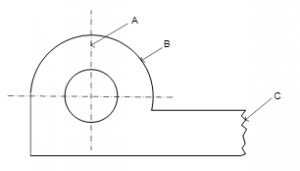This set of Civil Engineering Drawing Multiple Choice Questions & Answers (MCQs) focuses on “Lines, Lettering and Dimensioning”.
1. Which grade of pencil is used for drawing arrowheads?
a) 2H
b) 2B
c) 7H
d) H
View Answer
Explanation: Arrowheads resembles the extent of dimensions. It should be sharply defined and uniform throughout the drawing. Generally, 3 mm in length is used. For such precision small diameter pencils are used, hence 2H is used as arrowheads.
2. Which type is the line A in the following figure?

a) Dimension line
b) Extension line
c) Centre line
d) Short-break line
View Answer
Explanation: Centre line is used to indicate the axes of cylindrical, conical or spherical objects. Also to show the centre of circle and arcs. Long, thin chain line composed of alternate long and dot spaces approximately 1mm apart. Long dashes are about 9 to 12mm apart.
3. In n the following figure line C is used for irregular boundaries, what is its name?

a) Construction line
b) Long-break lines
c) Short-break line
d) Irregular line
View Answer
Explanation: Short- break lines usually shortens an object that otherwise would be longer at a real world scale. These are continuous, thin, heavy, semi-parallel, wavy lines. They are drawn free hand for consistent shaped objects and are used to show short break or irregular boundaries.
4. What type of line is B in the following figure?

a) Inner line
b) Outline
c) Outer line
d) Boundary line
View Answer
Explanation: Outlines represents a general sketch indicating only the main features, aspect of something under discussion. These are continuous thick, wide lines used to represent visible edges and surface boundaries of objects. Also known as principal lines.
5. What does the “Single-Stroke” lettering mean?
a) Cursive writing
b) Uniformity in letters as obtained in one stroke of the pencil
c) Writing in one stroke without lifting the pencil
d) Writing only with hard, small diameter lead-pencil
View Answer
Explanation: Single-Stroke lettering resembles uniformity in line thickness which can be obtained in one stroke. One stroke resembles the uniform lead diameter i.e. during lettering the thickness of letters should match each other.
6. Which line is drawn to make the section evident?
a) Long-break line
b) Chain thick
c) Border line
d) Hatching line
View Answer
Explanation: These lines are drawn to make the section bold or visible. These are continuous thin lines and are generally drawn at an angle of 45 degree to the main outline of the section. This figure
7. What is the general application of the line shown below?

a) Hidden edges
b) Extension
c) Cutting planes
d) Projection
View Answer
Explanation: Cutting plane lines represents a plane or planes in which a sectional view is taken. The arrow indicates the direction of cutting the section. Here the upper or front portion of the section will be visible (in the diagram above).
8. What is the slope of inclined letters with the horizontal?
a) 75 degree
b) 65 degree
c) 45 degree
d) 85 degree
View Answer
Explanation: Inclined letters are Single-stroke letters which lean to the right making a slope of 75 degree with the horizontal as per the guidance of Indian Standards. Also known as Italic lettering. Not recommended for beginners until you have mastered in vertical lettering. Inclined and vertical lettering should never appear on the same drawing.
9. In lettering ‘A’ the height of capital letter is divided in how many parts?
a) 10
b) 14
c) 16
d) 8
View Answer
Explanation: In lettering ‘A’ type, the height of the capital letter is divided into 14 parts while in lettering ‘B’ type it is divided into 10 parts. The height of letters and numerals for engineering drawing can be selected from 2.5, 3.5, 5, 7, 10, 14 and 20 mm according to drawing size.
10. The length to height ratio of a closed filled arrow head is?
a) 1:3
b) 3:1
c) 1:2
d) 2:1
View Answer
Explanation: This
Open closed closed filled oblique stroke
11. Guidelines for dimensions at international level on a drawing is controlled by __________
a) Bureau of Indian Standards
b) Corporate drafting standards
c) ANSI
d) ISO
View Answer
Explanation: ISO (International Organization for Standardization), this is a World Wide organization that creates engineering standards, dimensions with approximately 100 participating countries. ANSI creates standards for North America, BIS for India, CDS for small company.
12. The symbol shown below is _________
![]()
a) Radius
b) Depth
c) Diameter
d) Angle
View Answer
Explanation: The above symbol is used for diameter of circles irrespective of the units. The diameter symbol ⌀ is distinct from the empty set symbol ∅, from an (italic) uppercase phi Φ, and from the Nordic vowel ∅.
Sanfoundry Global Education & Learning Series – Civil Engineering Drawing.
To practice all areas of Civil Engineering Drawing, here is complete set of 1000+ Multiple Choice Questions and Answers.
If you find a mistake in question / option / answer, kindly take a screenshot and email to [email protected]
- Check Civil Engineering Drawing Books
- Check Civil Engineering Books
- Practice Civil Engineering MCQs
- Apply for Civil Engineering Internship
